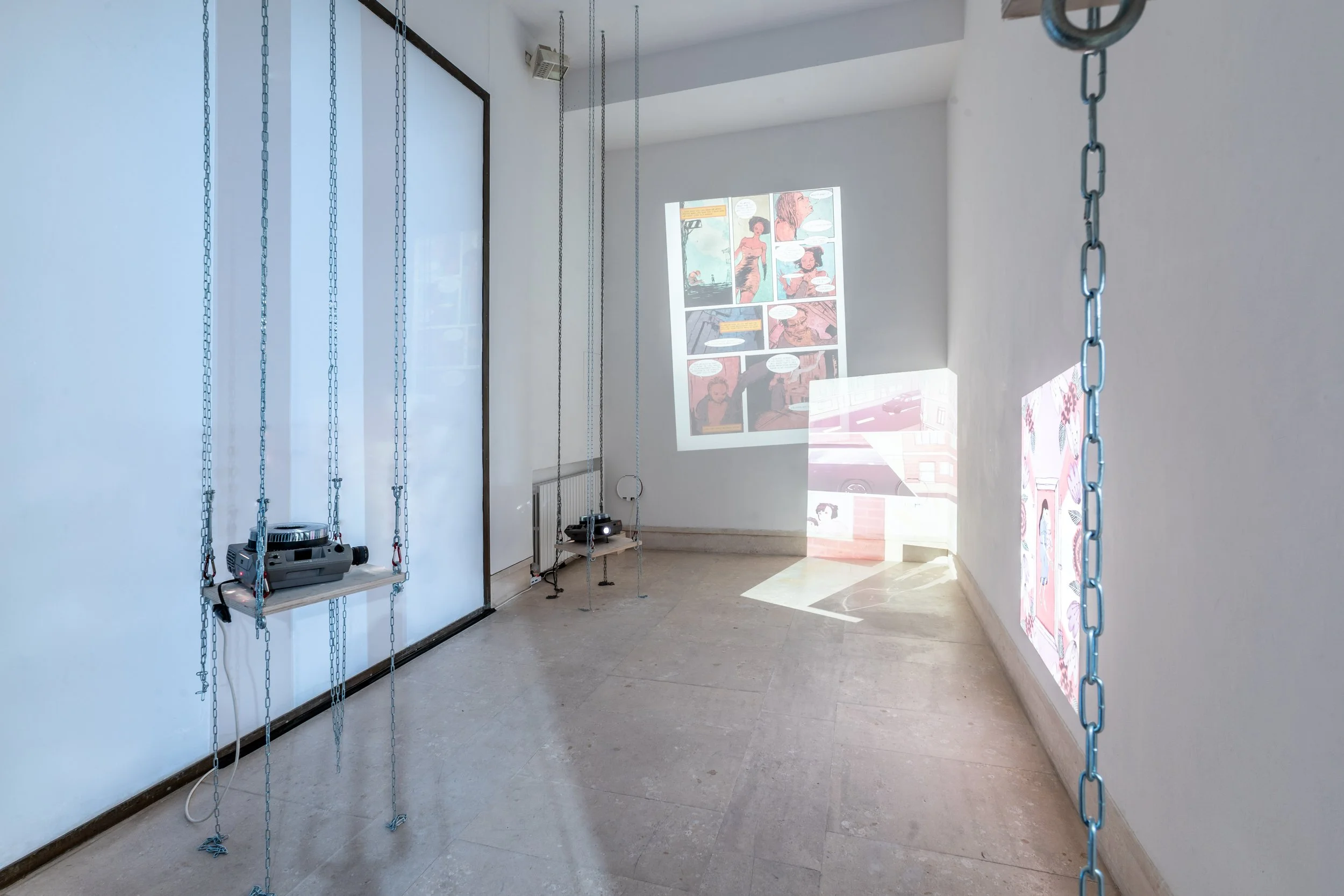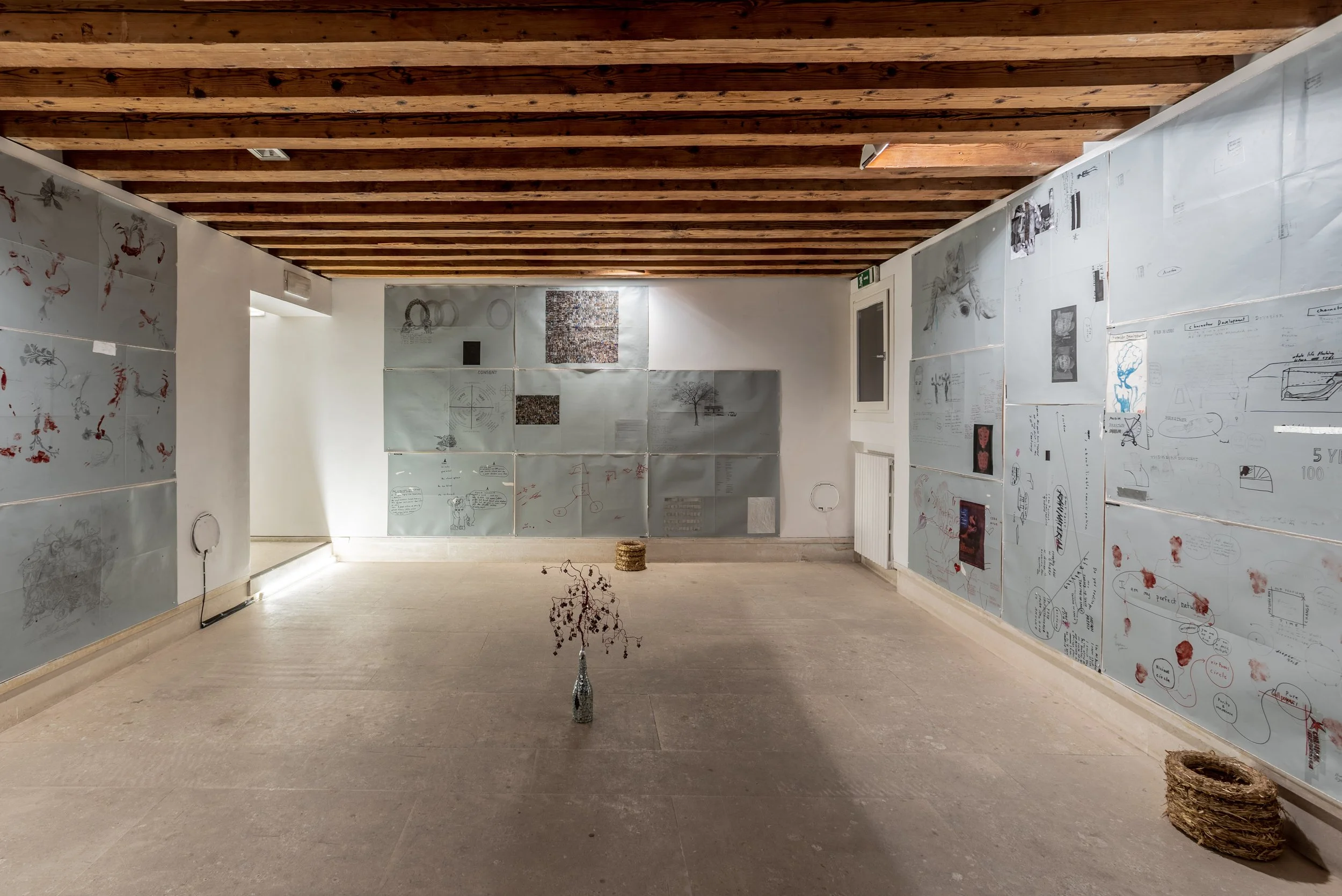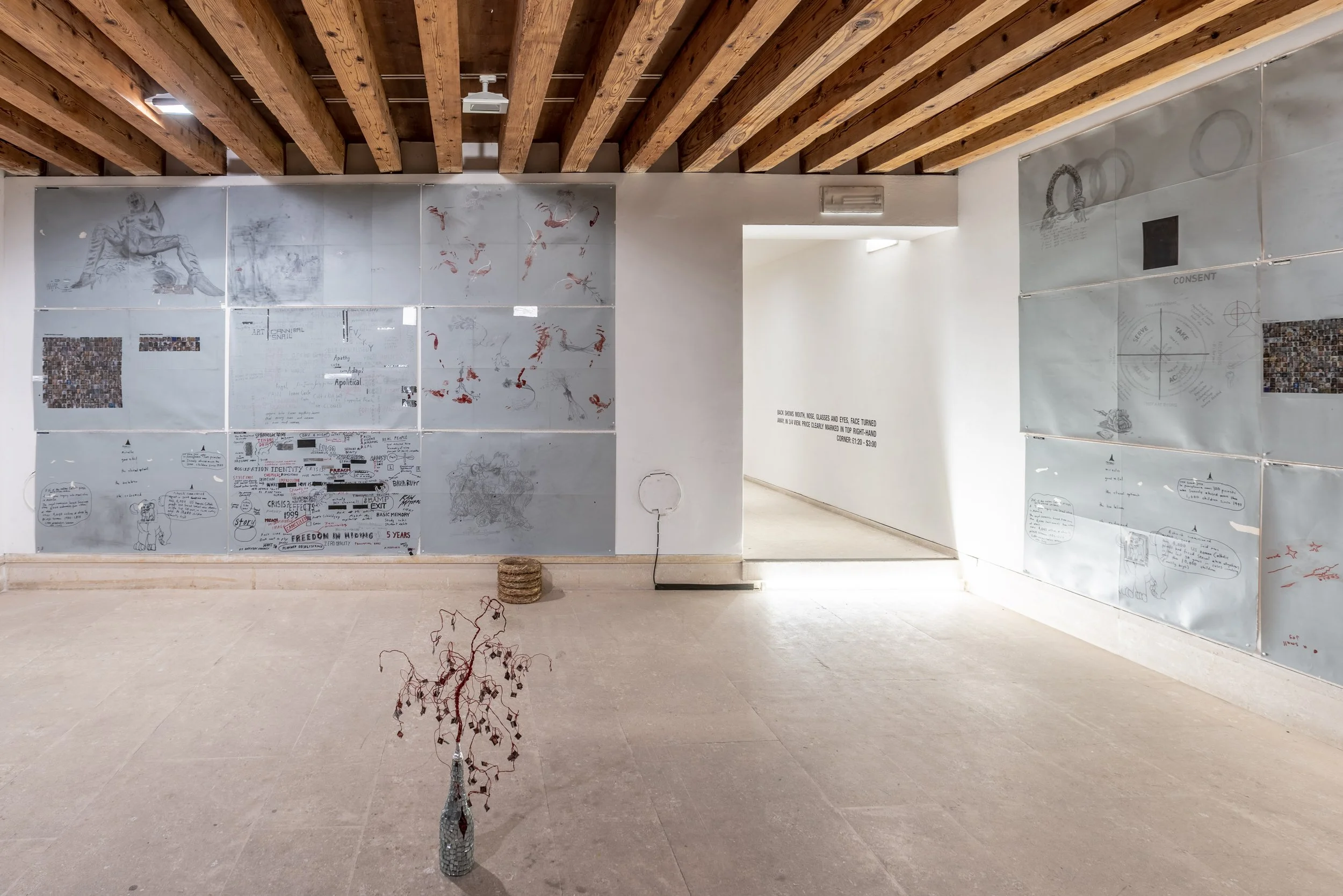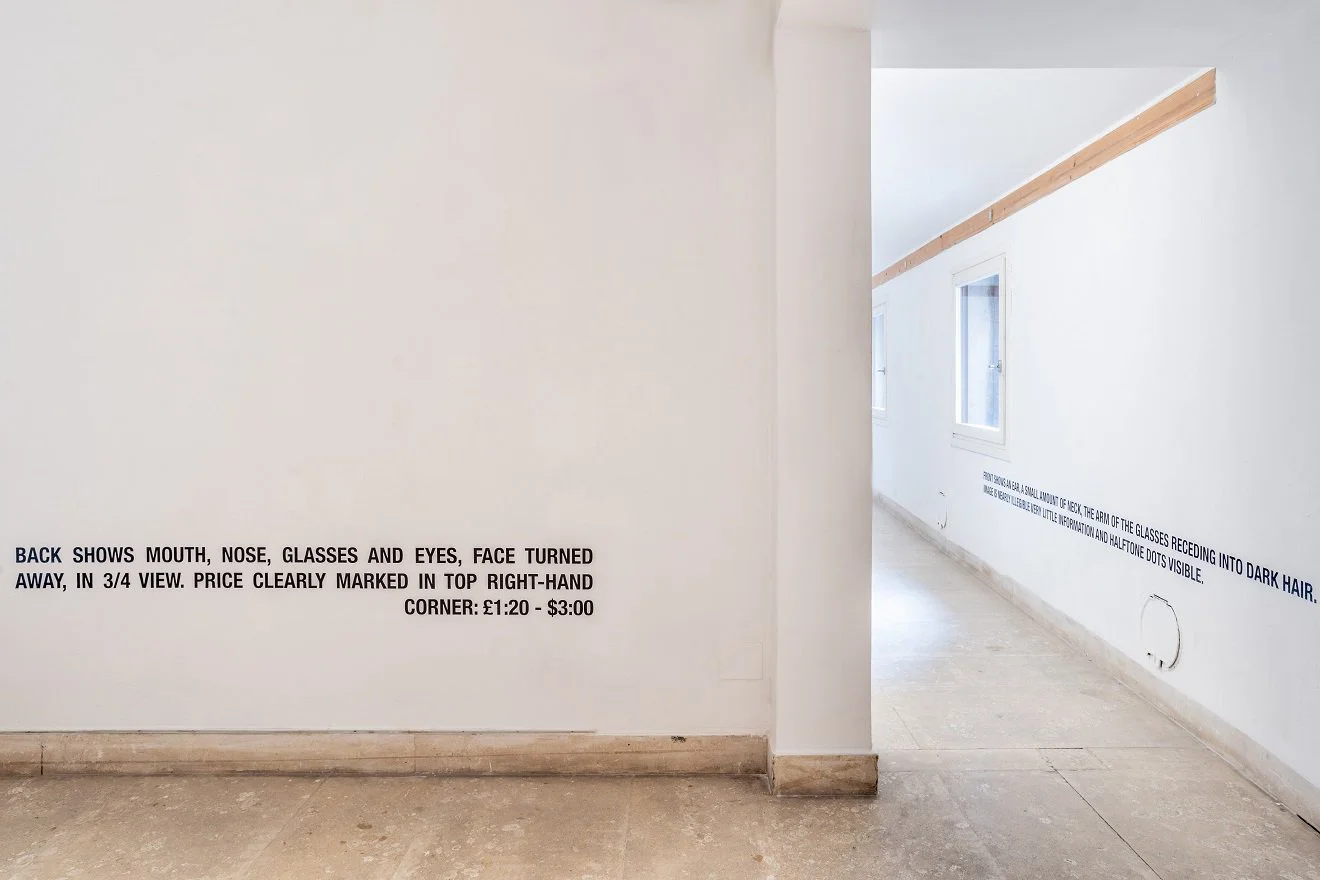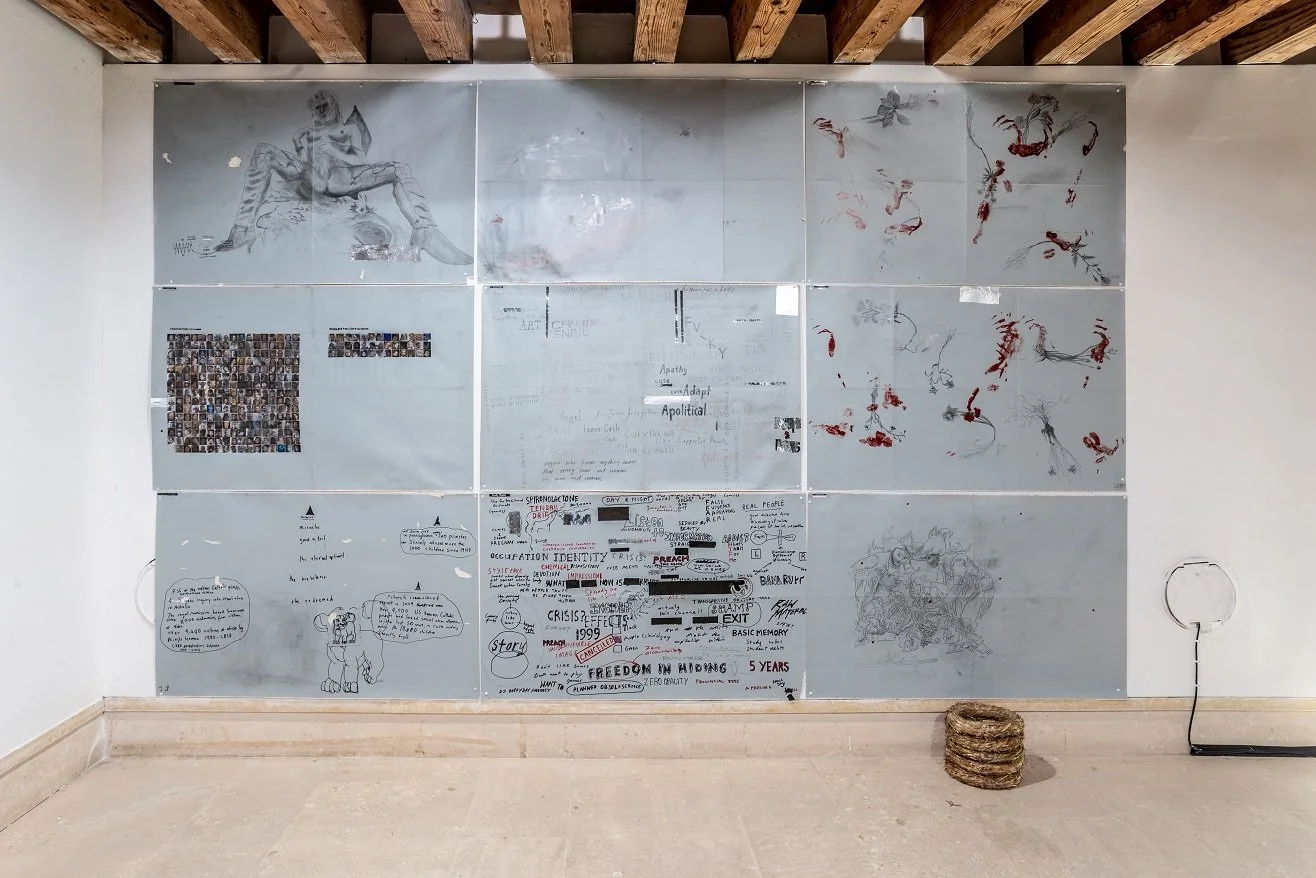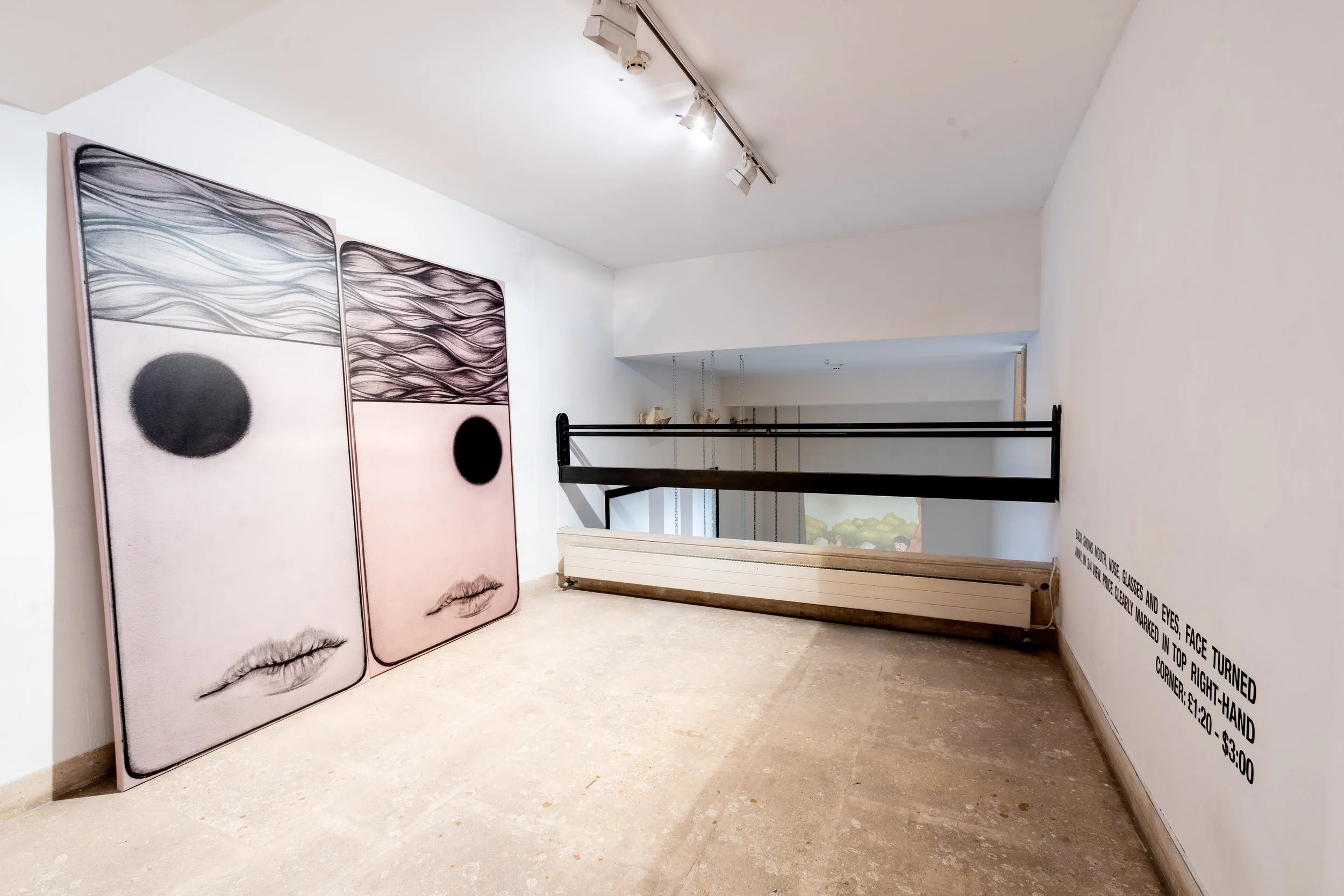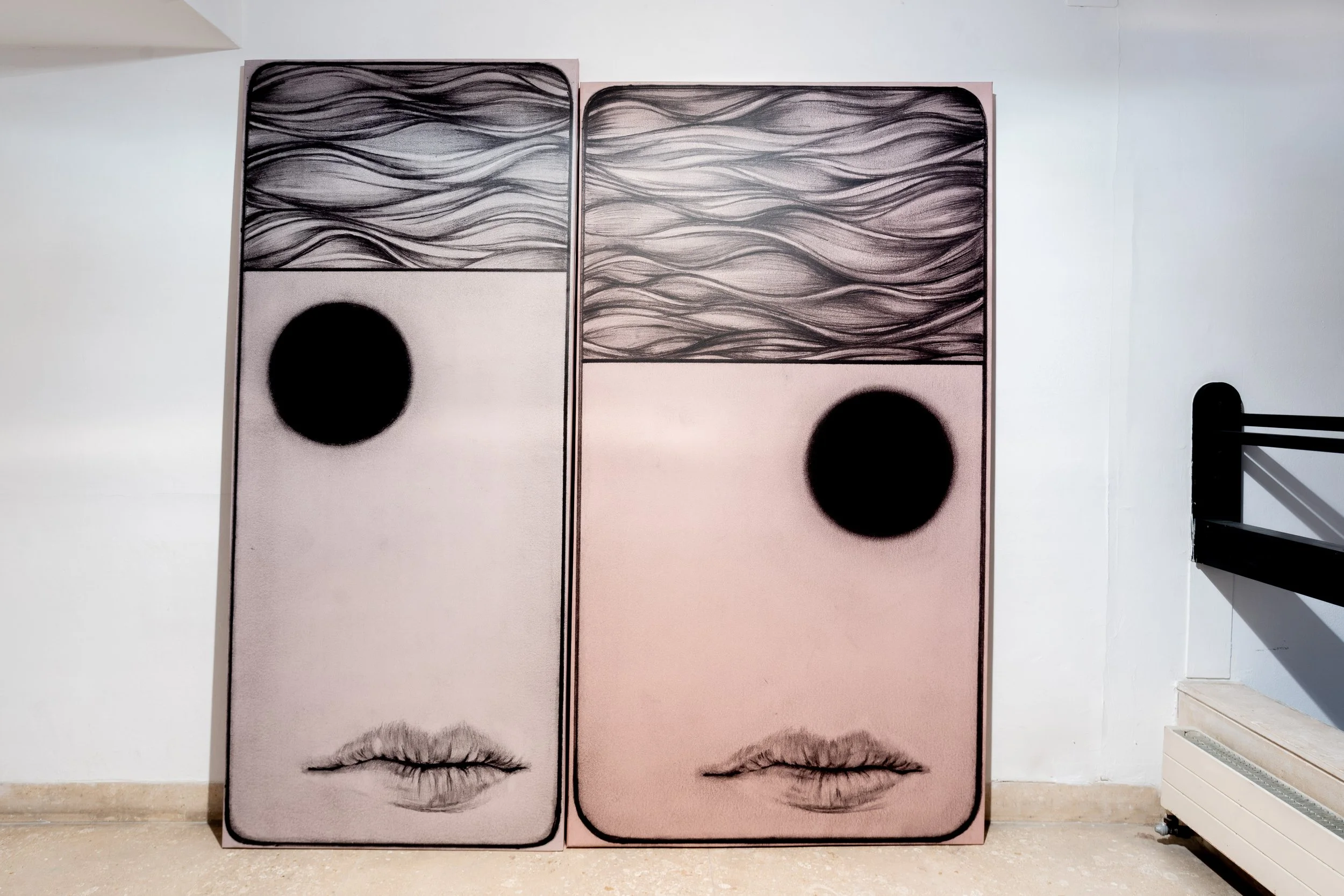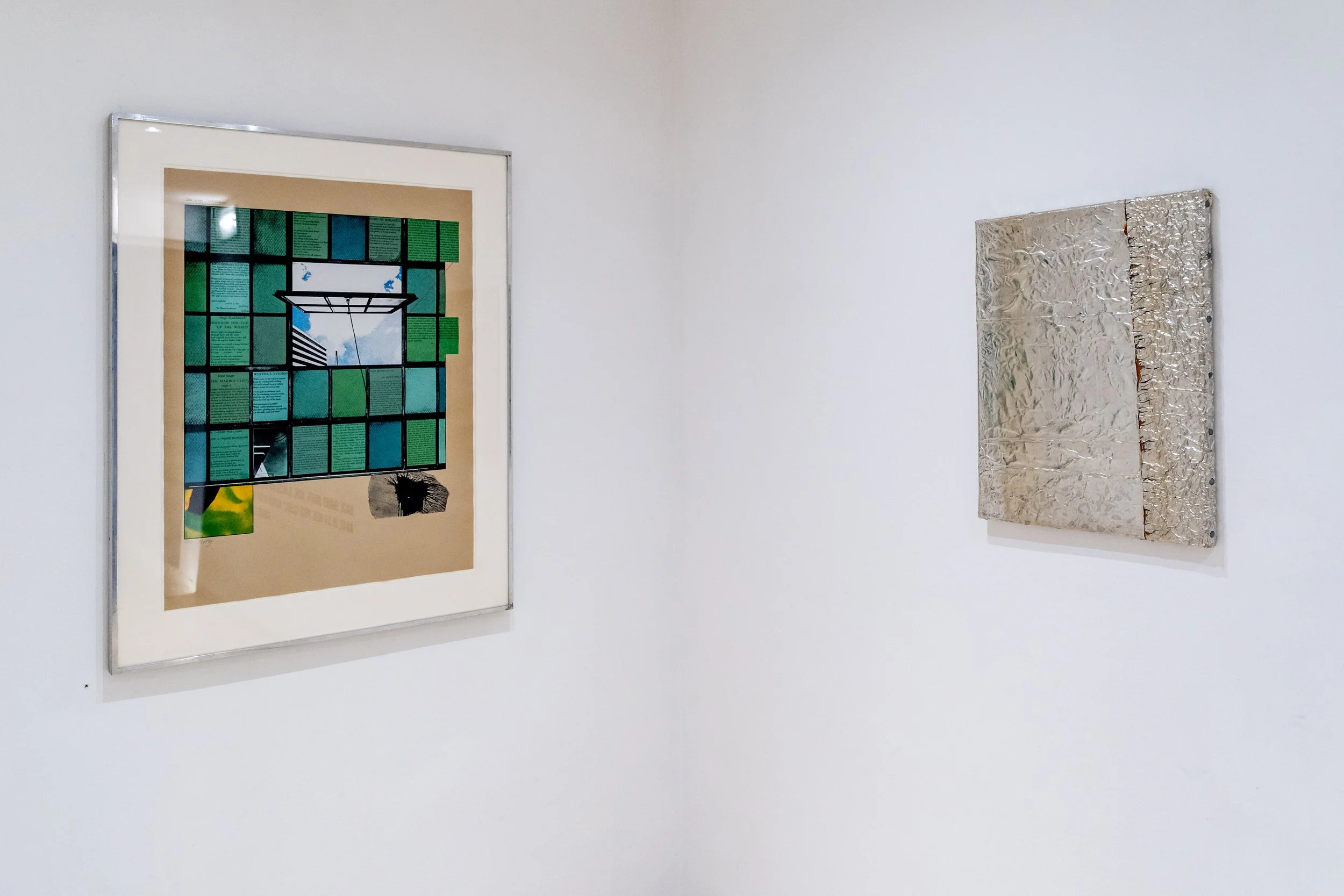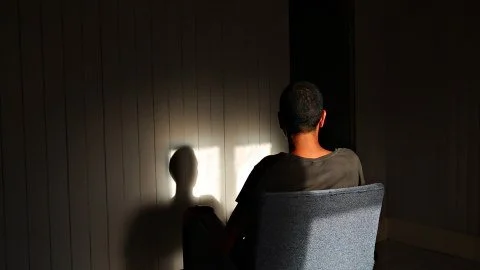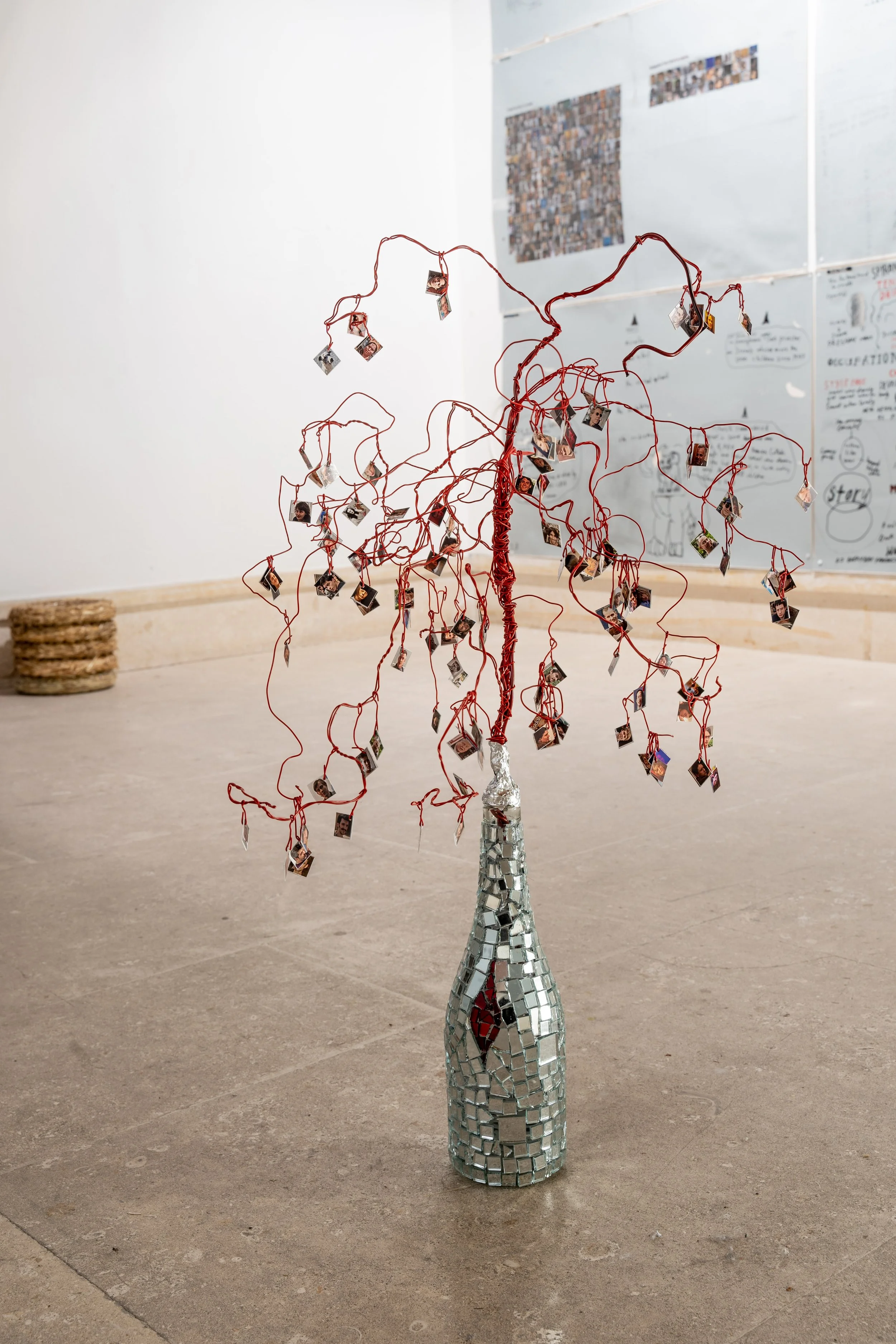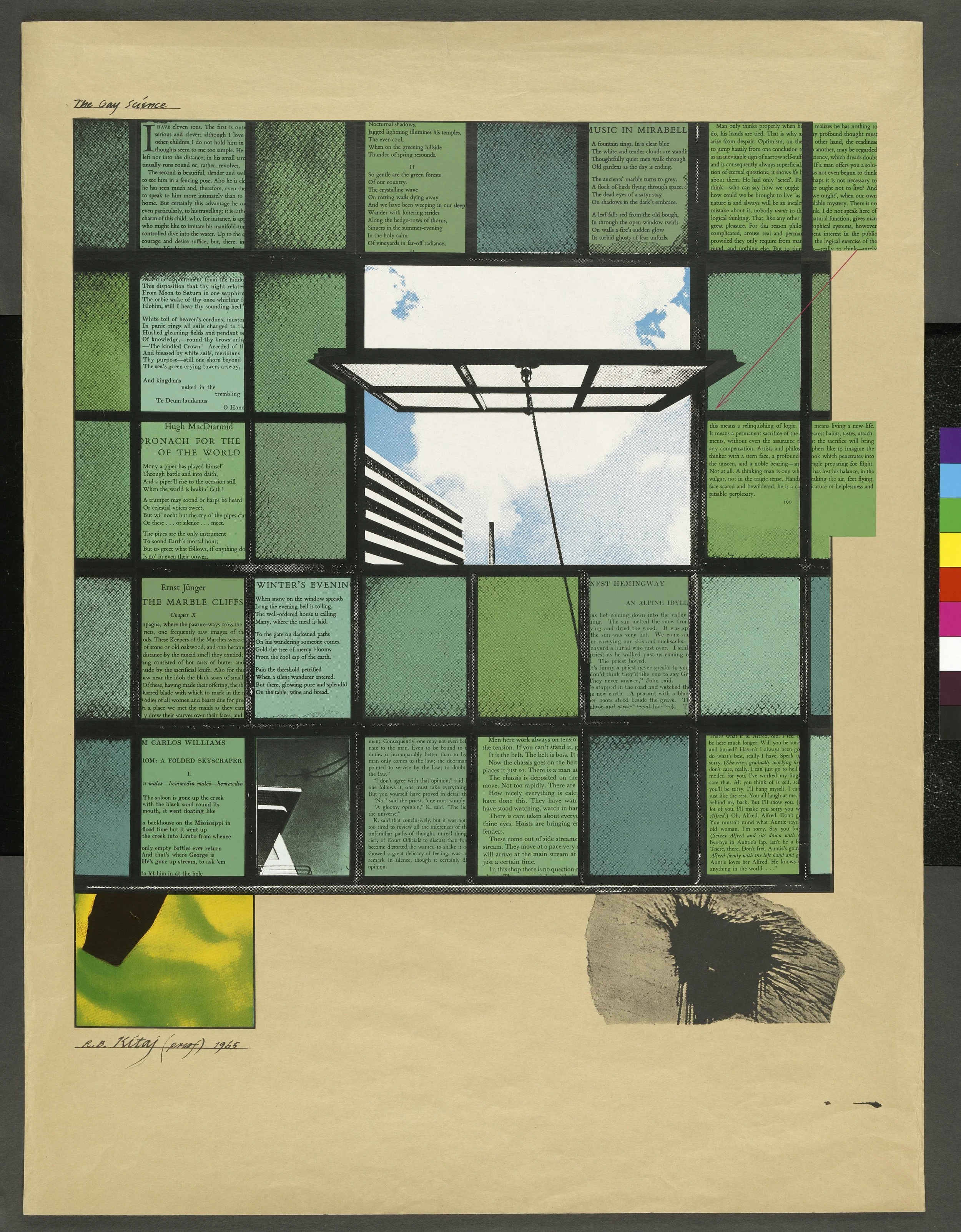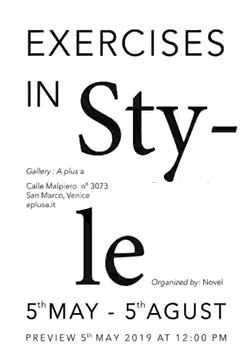
Exercises in Style
Exercises in Style
curated by NOVEL (Alun Rowlands & Matthew Williams)
A plus A Gallery
Calle Malipiero 3073, San Marco Venezia
aplusa.it
05 May - 05 August 2019
“Exercises in Style” at A plus A Gallery, Venice - Mousse Magazine
“Exercises in Style” at AplusA
- FAD Magazine
FRONT COVER: ILLUSTRATION IN FULL COLOUR, BORDERED BY BLACK OUTLINED FRAME, PALE PINK WASH BACKGROUND; CENTRE TOP, AUTHOR’S NAME IN CAPITALS WITH HANDWRITTEN TITLE; AT BOTTOM, INK AND WATERCOLOUR DRAWING OF A CRYING WOMAN LYING ON A PURPLE STORAGE STYLE BED WITH A FLORAL PATTERNED DUVET, ONE HAND TO HEAD AND THE OTHER ACROSS HER RIBS, WEARING RED SOCKS, BLACK UNDERPANTS AND A LIME GREEN SPOTTED T-SHIRT. CONTENTS INCLUDE TITLES SUCH AS: ‘THE VAMPIRES’, ‘FREELANCE’, ‘FREELANCE II’, ‘NATIONAL PROVINCIAL’, ‘COUNTER-CULTURE’, ‘ART FILM’, ‘REPRESSION’ AND ‘CAN THIS BE LOVE’.
Ghislaine Leung, Item Description (2019)
“When someone pushes your bed out of the ward, when you see that the sky becomes green, and when you would spare the curate the funeral sermon, then it is time for you to get up, gently, as children get up, when the morning light shimmers through the curtains, secretly, so that the sister does not see it-and quickly!
But he has already begun it, the curate, you hear there his voice, young and eager and unstoppable, you hear there, he already speaks. Let it happen! Let his good words be submerged in the blinding rain. Your grave is open. Let his swift confidence first become helpless, that it may be helped. When you leave him, he will no longer know in the end, if he has already begun. And because he doesn’t know, he gives the pallbearers the sign. And the pallbearers ask no more and take your coffin out again. And they take the wreath from the lid and give it back to the young man, who is standing with bowed head at the edge of the grave. The young man takes his wreath and rubs all the ribbons smooth, embarrassed, he lifts his face for a glance, and the rain dashes a few tears from his cheeks. Then the procession moves itself back along the walls. The candles in the small, ugly chapel are lit once again and the curate says the prayer for the dead, so that you can live. He shakes the young man’s hand violently and, in his embarrassment, wishes him much luck. It is his first funeral, and he blushes down to his collar. And before he can correct himself, the young man is gone. What remains to be done now? Luck has been wished, there remains nothing for him to do, but to send the dead home again.
Just the same, after that the hearse with your coffin drives back up the long street. To the left and to the right are houses, and in every window stand yellow narcissi, like the kind wound into every wreath, there is nothing to be done against it. Children press their faces against the shut panes, it rains, but one of them will run out of the door. He hangs on to the back of the hearse, is thrust off, and remains behind. The child covers his eyes with both hands and looks after you angrily. But where else should one swing, when one lives on the street to the cemetery?”
- Extract from Spiegelgeschichte (Mirror Story), Ilse Aichinger (1946)
“The threads of stories repeating, regurgitating, journeys of sugar and sweat, cookie cutter interruptions to lives burnt, scorched through power sways and parlour games futility scars time (…)
And you said ‘an identity is questioned only when it is menaced, as when the mighty begin to fall or when the wretched begin to rise or when the stranger enters the gates never thereafter to be a stranger. Identity would seem to be the garment one covers the nakedness of the self. In which case it is best that the garment be loose, a little like the robes of the desert through which one’s nakedness gives one the power to change the robes.’
And I said ‘how can you see who we are when others are pretending to know and understand. This means they don’t ever have to really find out. If you aren’t really seen then how do you find your way in other people’s night?’
And you said ‘because the responsibility of a writer is to excavate the experience of the people who produced him. Did you mean I could lay a trail and at the same time follow one? Every folk tale knows that story.”
- Extract from Helen Cammock, There’s a Hole in the Sky Part II: Listening to James Baldwin (2016)
“I spiral for eternity, so I find the moment and look down to see myself sitting in a chair with my legs on top of each other. My legs are creating a tall tower that’s topped with my far-right-knee. It’s hiding the view from my eyes.
My soul’s infinite twirl forces my mouth to open and as the first tickles of sound appears in my throat I feel a familiar itch at the back of my neck.
A mistake for me is just another step forward, and as the owner of fifteen legs I can proudly say that I have made many and learnt from them all”
- Keren Cytter, The Woman with Fifteen Legs, Centre for Contemporary Art, CCC Kitakyushu, Japan, 2015 p. 40, 20 x 14cm, paperback, edition 30
The lure of storytelling is strong, often troublesome, in the imaginative transformation of the world through fiction. A story’s power belongs to the speaking subject but also to the listening one, stuttering in the instantaneous and capricious rapport between them. Sedition and rumour strip a story to the minimal. It makes it easier to pass around in complexity until it no longer resembles its original form; a reminder that perhaps there is no difference between what a story is about and how it is told. What is opposed to this fiction is not the real. It is not the truth which is always that of the masters or colonizers, it is the story-telling function that gives the false the power which forges memory, a legend, a monster. A process, whereby, ideas take form through an exchange continuously copied incompletely, again and again.
Exercises in Style seeks divergent plots and narratives, giving space to performative encounters, investigating the stories and their tellers. Here, a page of text, poster, slideshow and painting need not be read in linear time, but absorbed in a glance, inhaled with a weight of sounds, haptic aesthetic forms, variations, streaming, spiralling – no longer constructing empathy between representation and human subjects but amplifying connections and impulses. The exhibition avoids singular storylines, coherent narratives, and the politics of representation, and calls instead for careful listening to the faintest signals of change.
Utilizing fiction and embodied experience for knowledge- and world-building, the participating artists deploy stories as social objects and images. What do these stories signal? Who can credibly tell them and when? How can we break dominant myths? And can we produce alternative stories? Why do we tell stories about and through art, and for whom? What is the relationship between the stories we tell and the realities of history, power, and systemic violence? Is there an efficacy of confessional, and emotional modes of storytelling, as they appear alongside their analytical, philosophical, and political others.
Story in Reverse, is a multi-part slide installation by Loretta Fahrenholz, based on Ilse Aichinger’s ‘Spiegelgeschichte’ / ‘Mirror Story’ (1949) - a linguistic experiment that narrates a young woman’s tragically failed life. In Aichinger’s text the beginning and the end of life merge, as the story of the woman starts at her grave and is then told backwards. Loretta Fahrenholz uses analogue slide projectors to display seven versions of the overlapping story. Commissioning illustrators via the freelance marketplace website Fiverr Fahrenholz asks each of them to transpose the story in its entirety into a comic. The different interpretations of Aichinger’s story are freely retold and illustrated through alternating styles and drawing. The result is a space in which images, stories and different temporal structures meld, and in which tragedy, virtuality and pop culture meet.
First formalised in 2016, Bob van der Wal’s Study Notes 2016, consists of the artist’s journals rendered in ink on paper. Traditionally a reserved preliminary practice, the study notes found here surround the gallery with a dense collection of unsolved reflections that shift between the personal and common. Drawings and text notes surround existential diagram, subject formation, stories of the Catholic church, sexual abuse; alongside statistics for climate change, diagrams of filmic narrative structures and hormonal chemistry. The provisional drawings, part didactic explanation and/or proof render pornographic images of bodies, economies of value, accumulation and risk. Study Notes is an extensive display a journal in the genre of ‘artist’s study’ far-reaching to the point of self-exploitative investment.
Helen Cammock, There’s a Hole in the Sky Part II: Listening to James Baldwin (2016)
Helen Cammock explores history and storytelling through layered, fragmented narratives. Using video, photography, installation, print and performance, she interrogates the ways in which stories are told, and acknowledges those who are rendered invisible by the hierarchy of histories. Cammock’s work is prefaced by writing, borrowing the words of others to use alongside her own. There’s a Hole in the Sky Part II: Listening to James Baldwin (2016) is set around an imagined conversation with writer James Baldwin. It considers migrations, forced or voluntary, by Black American writers and dancers who moved to Europe in search of work and wider recognition. The film layers multiple and varied experiences, exploring the dynamics of appropriation and power. The film explores spoken word, poetry and lyrical prose as sites of resistance and liberation, framing the way the voice can embody a space of both individual and collective agency.
The Woman with Fifteen Legs tells the true story of George Harrison’s secret daughter. This sweet and sour melodrama is accompanied by seemingly arbitrary yet unbearably seductive images that draw and reject reading back and forth from the twisted tale. This is the story of Elizabeth Krupp, a hard working woman that hides fifteen legs in her trousers. Determined to find the reason for the phenomenon, Elizabeth Knupp finds herself confronting a peaceful old woman named Dorothy Strauss. - Keren Cytter
RB Kitaj The Gay Science (1965) screen print; Josef Strau Walking Alone (2017) tin plate, tin wire, acrylic on canvas; Ghislaine Leung Item Description (2019) vinyl text
Anthony D Green, Face Unit #1 & Unit #2 (2019) operates as icons generated through a series of visual experiments that seek to disrupt the structure of an organism. Emphasising the face through ‘sustained’ interruption, re-coding and dismantling features, the paintings generate alternate visual constructions.
Josef Strau
Walking Alone (2017)
tin plate, tin wire, acrylic on canvas
2.11.72
Introduction
The story that follows is not ours. We do not know who wrote it.
It came into our hands as follows. Our reputation as writers was established almost wholly as authors of fiction, despite some editorial work, when we launched on a series of three interrelated novels with a marked sexual bias. Shortly after the first in this series was published, we received two anonymous letters, one one week, one the next. Both were signed ‘God’, both were postmarked Venice.
Six months later, a bulky envelope arrived, it contained the manuscript that follows. There was no covering letter. The postmark on the envelope was, again, Venice. Whether the author was or was not ‘God’, we have no idea. The letters were vulgar and illiterate, but the illiteracy at least may have been assumed. The story that follows will be judged unpleasant by many, illiterate it certainly is not.
Although we are naturally interested by the mystery of origins (and teased by a suspicion that it may be intended as a parody of our work) we find the story interesting in its own right. There are echoes of NOVEL, and like NOVEL the whole seems something between wavelength and frequency. Our duties as editor have been light. We have divided some very long paragraphs, we have corrected a few spelling mistakes and we have given the piece a provisional title.
Our motives in getting the story published here is to contact the author. If she still keeps a watchful eye on our writing, she will see that she has achieved print.
***
Bob van der Wal, Tree Study (people and pets) (2015-19) metal, glass, printed photographs
RB Kitaj
, The Gay Science (1965)
The fifteen screenprints which comprise ‘Mahler Becomes Politics, Beisbol’ are contained in a portfolio. Printed by Kelpra Studios on various papers the edition was published by Marlborough Fine Art Ltd London 1967. RB Kitaj said that the initial impulse to make this series of prints came from his friendship with Jonathan Williams and from Williams’s Mahler poems. The book, Mahler by Jonathan Williams (included in the portfolio) 44 pages long and published in 1966, is a book of poems which are, in the author’s words, ‘exercises in spontaneous composition to the movements of all the Mahler symphonies’. The title of the series, deliberately echoing a title such as Mourning becomes Electra indicates, by referring to factors which are polar in their contrast, the range of involvement and association which became part of the originally simple concept. ‘Beisbol’ is a phonetic rendering of the pronunciation south of the United States border of ‘baseball’.
We would like to thank all the artists for their participation and in particular to t Aurora Fonda and Sandro Pignotti for their kind support.
NOVEL is an editorial and curatorial project, publishing artists writing and texts that oscillates between modes of fiction and poetry. NOVEL acts in-between the potential performance of a script, and the indeterminate transcript of the event. The journal hosts a cacophony of voices that coalesce around writing as a core material of a number of artists exploring language and the speculative force of fiction. Here, art writing is an apparatus for knowledge capture, writing as parallel practice, writing as political fiction, writing as another adventure, renegotiating unfulfilled beginnings or incomplete projects.








